Effect of Axial and Radial Flow on the Hydrodynamics in a Taylor Reactor
Abstract
1. Introduction
2. Materials and Methods
2.1. Governing Equations
2.2. External Axial through Flow
2.3. Numerical Method
2.4. Parameters Setting and Quantities
2.5. Nomenclature
3. Results and Discussion
3.1. Variation with Axial Flow
Absence of Radial Flow ()
3.2. Bifurcation Behavior with Radial Flow
3.3. Parameter Space
3.4. Flow Dynamics, Structures and Heteroclinic Connections
3.4.1. Anharmonicity
3.4.2. Axial Mean Flow
3.5. Unstable States
Torque Variation with
4. Conclusions
- (1)
- The () parameter space (Figure 4) illustrates a very rich variety of flow structures.
- (2)
- For any finite axial through flow an increase in initial decreases the symmetry before it eventually increases the symmetry of the flow states, TVF and SPI (Figure 6). Similarly, the degree of anharmonicity decreases with increasing for all (pure) states (Figure 7). Interestingly, with increasing , the axial mean flow for helical SPI, natural propagating in the direction of the applied external axial flow becomes closer to the profile of toroidal TVF (Figure 9).
- (3)
- Depending on various system parameters, heteroclinic connections between two topological different unstable solutions (1-mwTVF↔1-mwSPI) are found. The connection between these states appears to be of oscillatory type.
- (4)
- Combination and can result in significant enhancement in torque for different flow states, allowing for better selection between them (Figure 14).
Funding
Informed Consent Statement
Data Availability Statement
Acknowledgments
Conflicts of Interest
Nomenclature
References
- Taylor, G.I. Stability of a viscous liquid contained between two rotating cylinders. Philos. Trans. R. Soc. Lond. A 1923, 223, 289. [Google Scholar]
- Chossat, P.; Iooss, G. The Couette–Taylor Problem; Springer: Berlin, Germany, 1994. [Google Scholar]
- Yin, J.; Liu, X.; Zhou, C.; Zhu, Z. Analysis and measurement of mixing flow field on side wall of large-scale mixing tank. Chem. Eng. 2021, 49, 73–78. [Google Scholar]
- Zhu, J.; Liu, D.; Tang, C.; Chao, C.Q.; Wang, C.L. Study of Slit Wall Aspect Ratio Effect on the Taylor Vortex Flow. J. Eng. Thermophys. 2016, 37, 1208–1211. [Google Scholar]
- Hallström, B.; Lopez-Leiva, M. Description of a rotating ultrafiltration module. Desalination 1978, 24, 273. [Google Scholar] [CrossRef]
- Kroner, K.H.; Nissinen, V. Dynamic filtration of microbial suspension using an axially rotating filter. J. Membr. Sci. 1998, 36, 85. [Google Scholar] [CrossRef]
- Belfort, G.; Pimbley, J.M.; Greiner, A.; Chung, K.Y. Diagnosis of membrane fouling using a rotating annular filter. 1. cell culture media. Membr. Sci. 1993, 77, 1. [Google Scholar] [CrossRef]
- Belfort, G.; Mikulasek, P.; Pimbley, J.M.; Chung, K.Y. Diagnosis of membrane fouling using a rotating annular filter. 2. dilute particule suspension of known particle size. J. Membr. Sci. 1993, 77, 23. [Google Scholar] [CrossRef]
- Wereley, S.T.; Akonur, A.; Lueptow, R.M. Particle-fluid velocities and fouling in rotating filtration of a suspension. J. Membr. Sci. 2002, 209, 469. [Google Scholar] [CrossRef]
- Ohashi, K. Rotation-induced Taylor vortex enhances filtrate flux in plasma separation. Trans. Am. Soc. Artif. Intern. Organs 1988, 34, 300. [Google Scholar]
- Lueptow, R.M.; Hajiloo, A. Flow in a rotating membrane plasma separator. Trans. Am. Soc. Artif. Intern. Organs 1995, 41, 182. [Google Scholar] [CrossRef]
- Beaudoin, G.; Jaffrin, M.Y. Plasma filtration in couette flow membrane devices. Artif. Organs 1989, 13, 43. [Google Scholar] [CrossRef] [PubMed]
- Aziz, M.; Owis, F.; Abdelrahman, M. Preliminary design of a transonic fan for a low by-pass turbofan engine. Int. Rev. Aerosp. Eng. 2013, 6, 114–127. [Google Scholar]
- Hassan, H.Z.; Gobran, M.H.; El-Azim, A.A. Simulation of a transonic axial flow fan of a high bypass ratio turbofan engine during flight conditions. Int. Rev. Aerosp. Eng. 2014, 7, 17–24. [Google Scholar] [CrossRef]
- Lei, M.; Li, M. High-Performance Manufacturing Principle and Application of Thrust Bearings of Primary Pump in Nuclear Power Plant. China Nucl. Power 2020, 13, 592–598. [Google Scholar]
- Giordano, R.C.; Giordano, R.L.C.; Prazeres, D.M.F.; Cooney, C.L. Analysis of a Taylor–Poiseuille vortex flow reactor–I: Flow patterns and mass transfer characteristics. Chem. Eng. Sci. 1998, 53, 3635–3652. [Google Scholar] [CrossRef]
- Giordano, R.L.C.; Giordano, R.C.; Prazeres, D.M.F.; Cooney, C.L. Analysis of a Taylor–Poiseuille vortex flow reactor–II: Reactor modeling and performance assessment using glucose-fructose isomerization as test reaction. Chem. Eng. Sci. 2000, 55, 3611–3626. [Google Scholar] [CrossRef]
- Resende, M.M.; Tardioli, P.W.; Fernandez, V.M.; Ferreira, A.L.O.; Giordano, R.L.C.; Giordano, R.C. Distribution of suspended particles in a Taylor-Poiseuille vortex flow reactor. Chem. Eng. Sci. 2001, 56, 755–761. [Google Scholar] [CrossRef]
- Resende, M.M.; Vieira, P.G.; Sousa, R., Jr.; Giordano, R.L.C.; Giordano, R.C. Estimation of mass transfer parameters in a Taylor–Couette-Poiseuille heterogeneous reactor. Braz. J. Chem. Eng. 2004, 21, 175–184. [Google Scholar] [CrossRef]
- Ostilla-Mónico, R.; Van der Poel, E.; Verzicco, R.; Grossmann, S.; Lohse, D. Exploring the phase diagram of fully turbulent Taylor–Couette flow. J. Fluid Mech. 2014, 761, 1–26. [Google Scholar] [CrossRef]
- Richter, O.; Menges, M.; Kraushaar-Czarnetzki, B. Investigation of mixing in a rotor shape modified Taylor Vortex reactor by the means of a chemical test reaction. Chem. Eng. Sci. 2009, 64, 2384–2391. [Google Scholar] [CrossRef]
- Deng, R.; Arifin, D.Y.; Chyn, M.Y.; Wang, C.H. Taylor vortex flow in presence of internal baffles. Chem. Eng. Sci. 2010, 65, 4598–4605. [Google Scholar] [CrossRef]
- Carlos Álvarez, M.; Vicente, W.; Solorio, F.; Mancilla, E.; Salinas, M.; Zenit, V.R. A study of the Taylor–Couette flow with finned surface rotation. J. Appl. Fluid Mech. 2019, 12, 1371–1382. [Google Scholar] [CrossRef]
- Bakhuis, D.; Ezeta, R.; Berghout, P.; Bullee, P.A.; Tai, D.; Chung, D.; Verzicco, R.; Lohse, D.; Huisman, S.G.; Sun, C. Controlling secondary flow in Taylor–Couette turbulence through spanwise-varying roughness. J. Fluid Mech. 2019, 883, 654–662. [Google Scholar] [CrossRef]
- Min, K.; Lueptow, R.M. Hydrodynamic stability of viscous flow between rotating porous cylinders with radial flow. Phys. Fluids 1994, 6, 144. [Google Scholar] [CrossRef]
- Chang, S.; Sartory, W.K. Hydromagnetic stability of dissipative flow between rotating permeable cylinders. J. Fluid Mech. 1967, 27, 65–79. [Google Scholar] [CrossRef]
- Kolyshkin, A.A.; Vaillancourt, R. Convective instability boundary of Couette flow between rotating porous cylinders with axial and radial flows. Phys. Fluids 1997, 9, 910–918. [Google Scholar] [CrossRef]
- Martinand, D.; Serre, E.; Lueptow, R. Absolute and convective instability of cylindrical Couette flow with axial and radial flows. Phys. Fluids 2009, 21, 104102. [Google Scholar] [CrossRef]
- Martinand, D.; Serre, E.; Lueptow, R. Linear and weakly nonlinear analyses of cylindrical Couette flow with axial and radial flows. J. Fluid Mech. 2017, 824, 438. [Google Scholar] [CrossRef]
- Johnson, E.C.; Lueptow, R.M. Hydrodynamic stability of flow between rotating porous cylinders with radial and axial flow. Phys. Fluids 1997, 9, 3687. [Google Scholar] [CrossRef][Green Version]
- Altmeyer, S. Flow dynamics between two concentric counter-rotating porous cylinders with radial through-flow. Phys. Rev. Fluids 2021, 6, 124802. [Google Scholar] [CrossRef]
- Schwille, A. Mitra, D.; Lueptow, R.M. Design parameters for rotating cylindrical filtration. J. Membr. Sci. 2002, 204, 53. [Google Scholar] [CrossRef]
- Lee, S.; Lueptow, R.M. Rotating membrane filtration and rotating reverse osmosis. J. Chem. Eng. Jpn. 2004, 37, 471. [Google Scholar] [CrossRef]
- Masliyah, J.; Zhou, Z.J.; Xu, Z.; Czarnecki, J.; Hamza, H. Understanding water-based bitumen extraction from Athabasca oil sands. Can. J. Chem. Eng. 2004, 82, 628. [Google Scholar]
- Leite, R.J. An experimental investigation of the stability of Poiseuille flow. J. Fluid Mech. 1959, 5, 81. [Google Scholar] [CrossRef]
- Chandrasekhar, S. Hydrodynamic and Hydromagnetic Stability; Dover: New York, NY, USA, 1961. [Google Scholar]
- Hughes, S.; Randriamampianina, A. An improved projection scheme applied to pseudospectral methods for the incompressible Navier Stokes equations. Int. J. Numer. Methods Fluids 1998, 28, 501. [Google Scholar] [CrossRef]
- Mercader, I.; Batiste, O.; Alonso, A. An efficient spectral code for incompressible flows in cylindrical geometries. Comput. Fluids 2010, 39, 215. [Google Scholar]
- Altmeyer, S.; Hoffmann, C.; Heise, M.; Abshagen, J.; Pinter, A.; Lücke, M.; Pfister, G. End wall effects on the transitions between Taylor vortices and spiral vortices. Phys. Rev. E 2003, 81, 066313. [Google Scholar] [CrossRef]
- Peyret, R.; Taylor, T.D. Computational Methods in Fluid Flow; Springer: Berlin, Germany, 1983. [Google Scholar]
- Schulz, A.; Pfister, G. Physics of Rotating Fluids; Eghers, C., Pfister, G., Eds.; Springer: Berlin, Germany, 2000; Volume 549, p. 37. [Google Scholar]
- Altmeyer, S.; Hoffmann, C.; Heise, M.; Abshagen, J.; Pinter, A.; Pfister, G.; Lücke, M. End wall effects on the transitions between Taylor vortices and spiral vortices. Phys. Rev. E 2010, 81, 066313. [Google Scholar]
- Recktenwald, A.; Lücke, M.; Müller, H.W. Taylor vortex formation in axial through-flow: Linear and weakly nonlinear analysis. Phys. Rev. E 1993, 48, 4444. [Google Scholar]
- Altmeyer, S.; Hoffmann, C.; Lücke, M. Islands of instability for growth of spiral vortices in the Taylor–Couette system with and without axial through-flow. Phys. Rev. E 2011, 84, 046308. [Google Scholar]
- Pinter, A.; Lücke, M.; Hoffmann, C. Spiral and Taylor vortex fronts and pulses in axial through-flow. Phys. Rev. E 2003, 67, 26318. [Google Scholar]
- Hoffmann, C.; Lücke, M.; Pinter, A. Spiral vortices and Taylor vortices in the annulus between rotating cylinders and the effect of an axial flow. Phys. Rev. E 2004, 69, 056309. [Google Scholar] [CrossRef]
- Abchaa, N.; Crumeyrolle, O.; Ezerskya, A.B.; Mutabazi, I. Velocity field of the spiral vortex flow in the Couette-Taylor system. Eur. Phys. J. E 2013, 36, 20. [Google Scholar] [CrossRef]
- Guckenheimer, J.; Holmes, P. Structurally stable heteroclinic cycles. Math. Proc. Camb. Phil. Soc. 1988, 103, 189–192. [Google Scholar] [CrossRef]
- Melbourne, I.; Chossat, P.; Golubitsky, M. Heteroclinic cycles involving periodic solutions in mode interactions with O(2) symmetry. Proc. Roy. Soc. Edinb. 1989, 113A, 315–345. [Google Scholar] [CrossRef]
- Krupa, M.; Melbourne, I. Asymptotic stability of heteroclinic cycles in systems with symmetry. Ergod. Th. Dynam. Sys. 1995, 15, 121–147. [Google Scholar] [CrossRef]
- Krupa, M. Robust heteroclinic cycles. J. Nonlin. Sci. 1997, 7, 129–176. [Google Scholar] [CrossRef]
- Altmeyer, S. Non-linear dynamics and alternating ‘flip’ solutions in ferrofluidic Taylor–Couette flow. J. Magn. Magn. Mater. 2018, 452, 427. [Google Scholar] [CrossRef]
- Eckhardt, B.; Grossmann, S.; Lohse, D. Torque scaling in turbulent Taylor–Couette flow between independently rotating cylinders. J. Fluid Mech. 2007, 581, 221. [Google Scholar] [CrossRef]
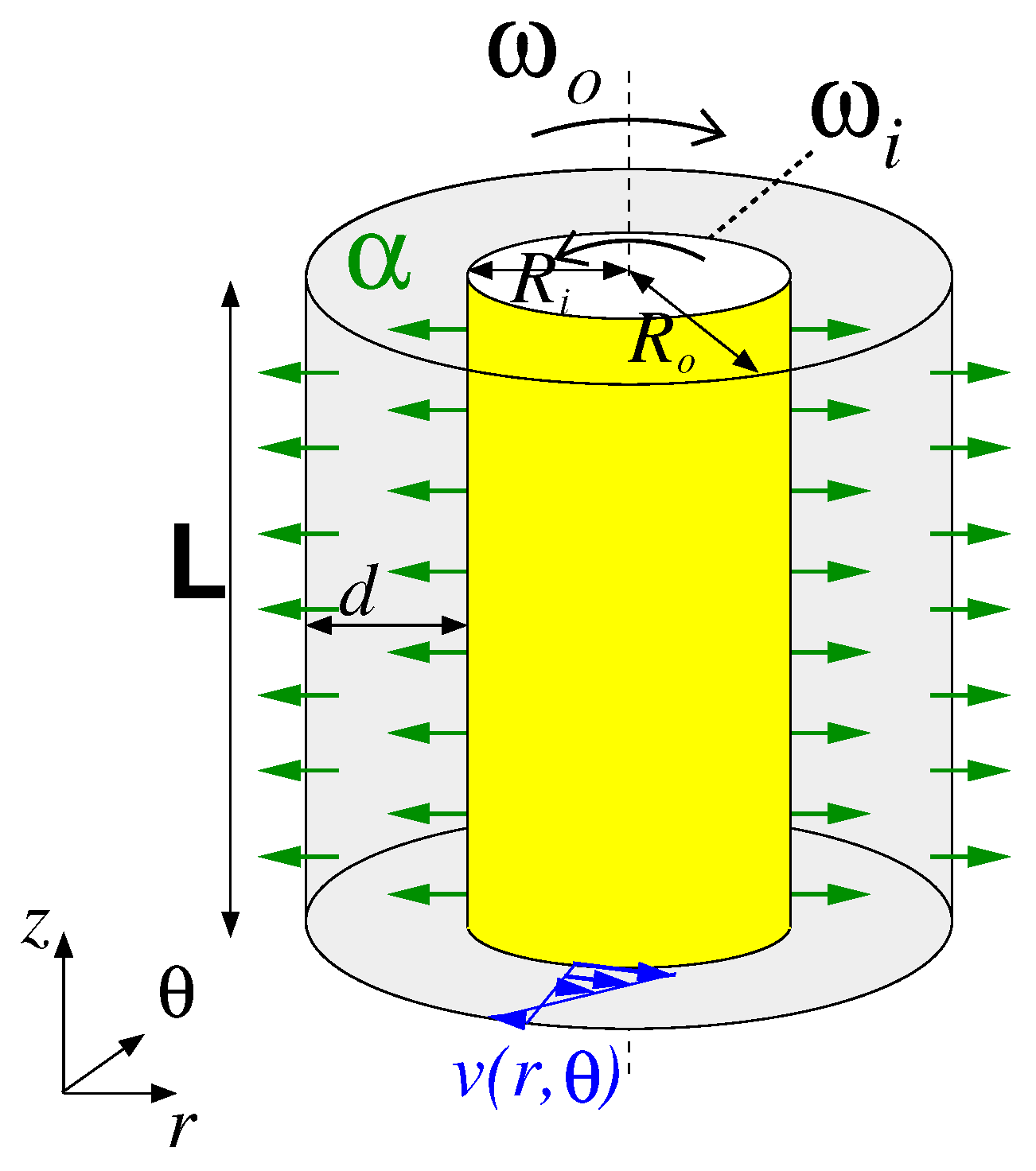
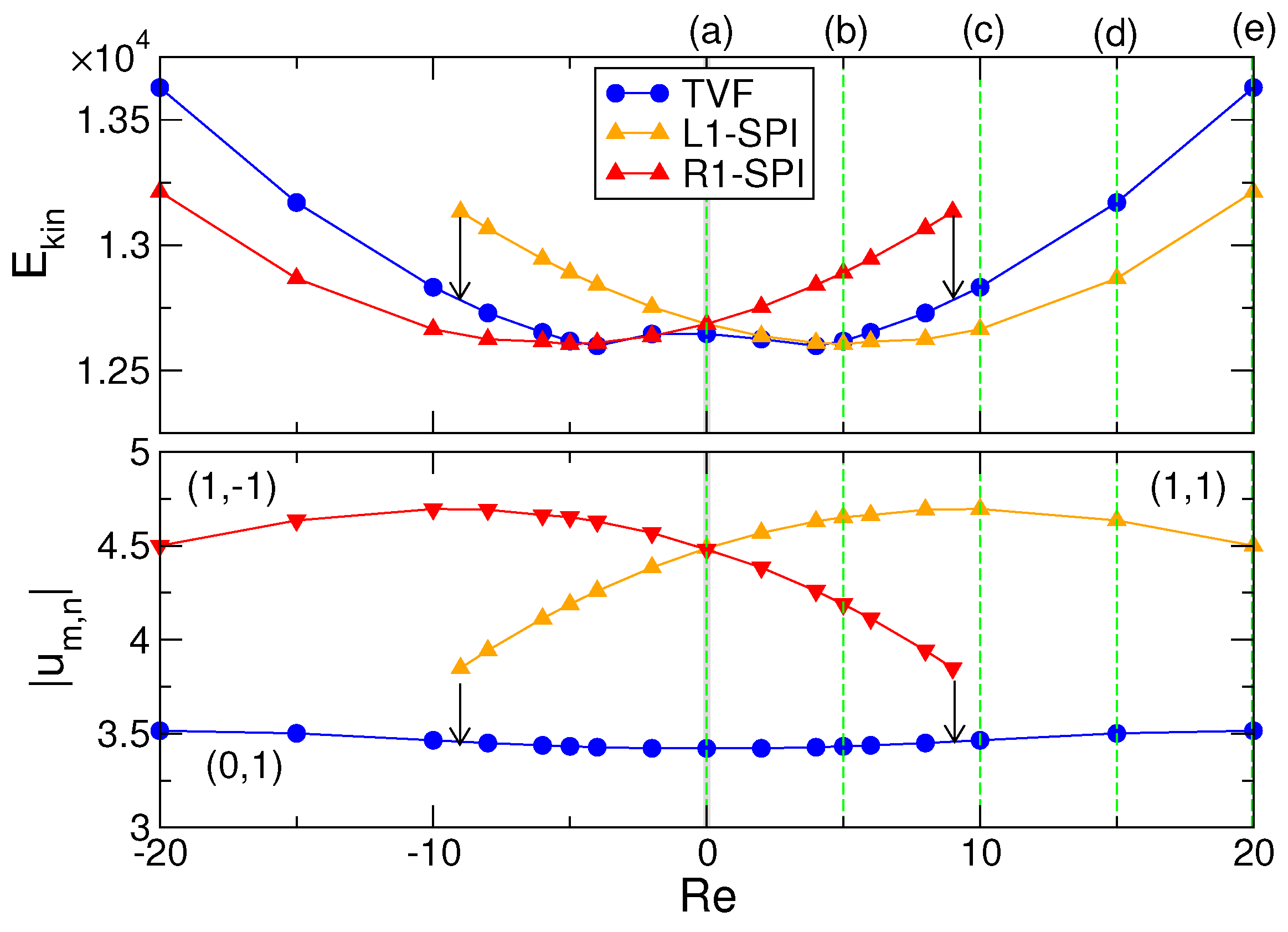

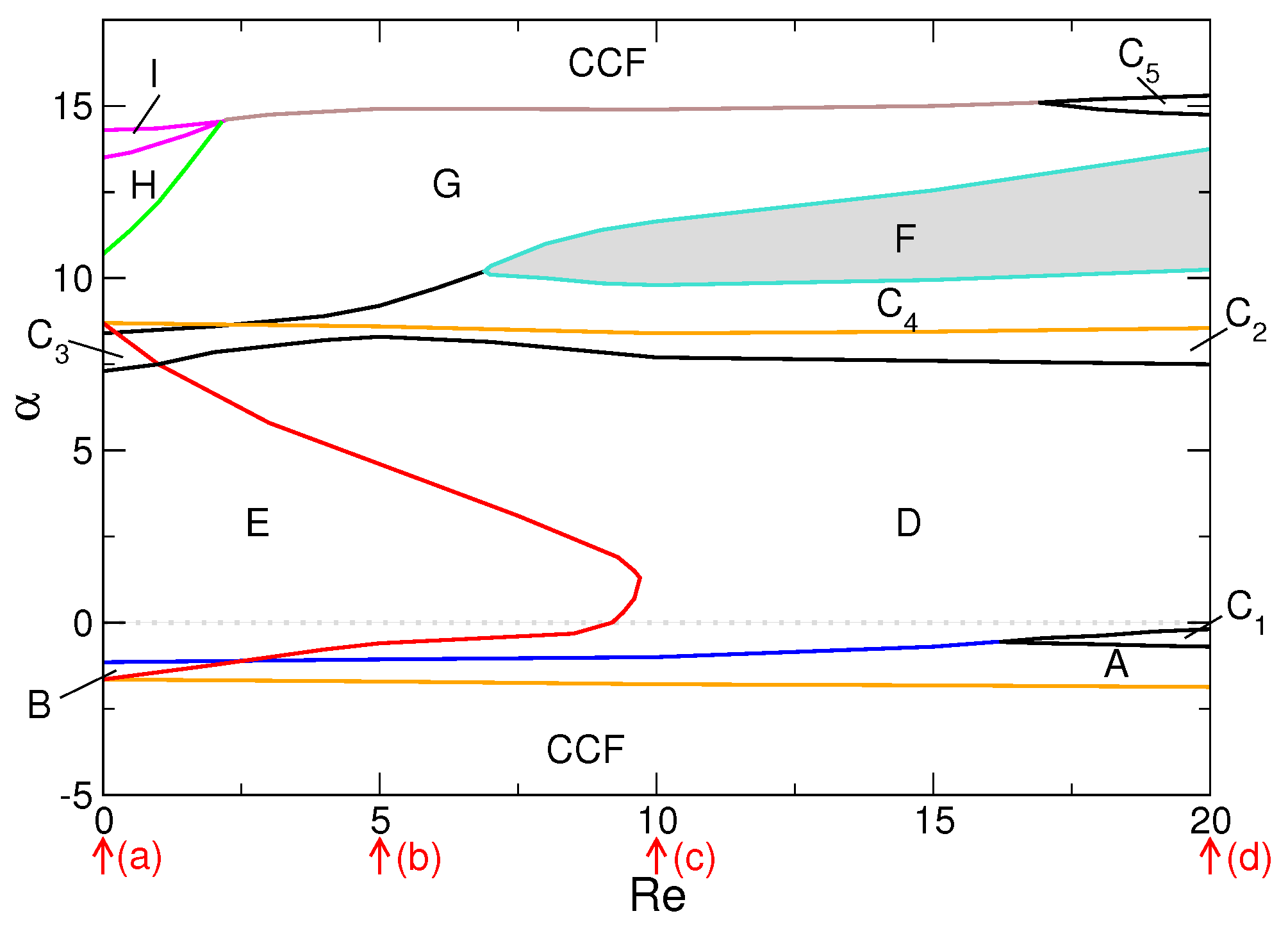
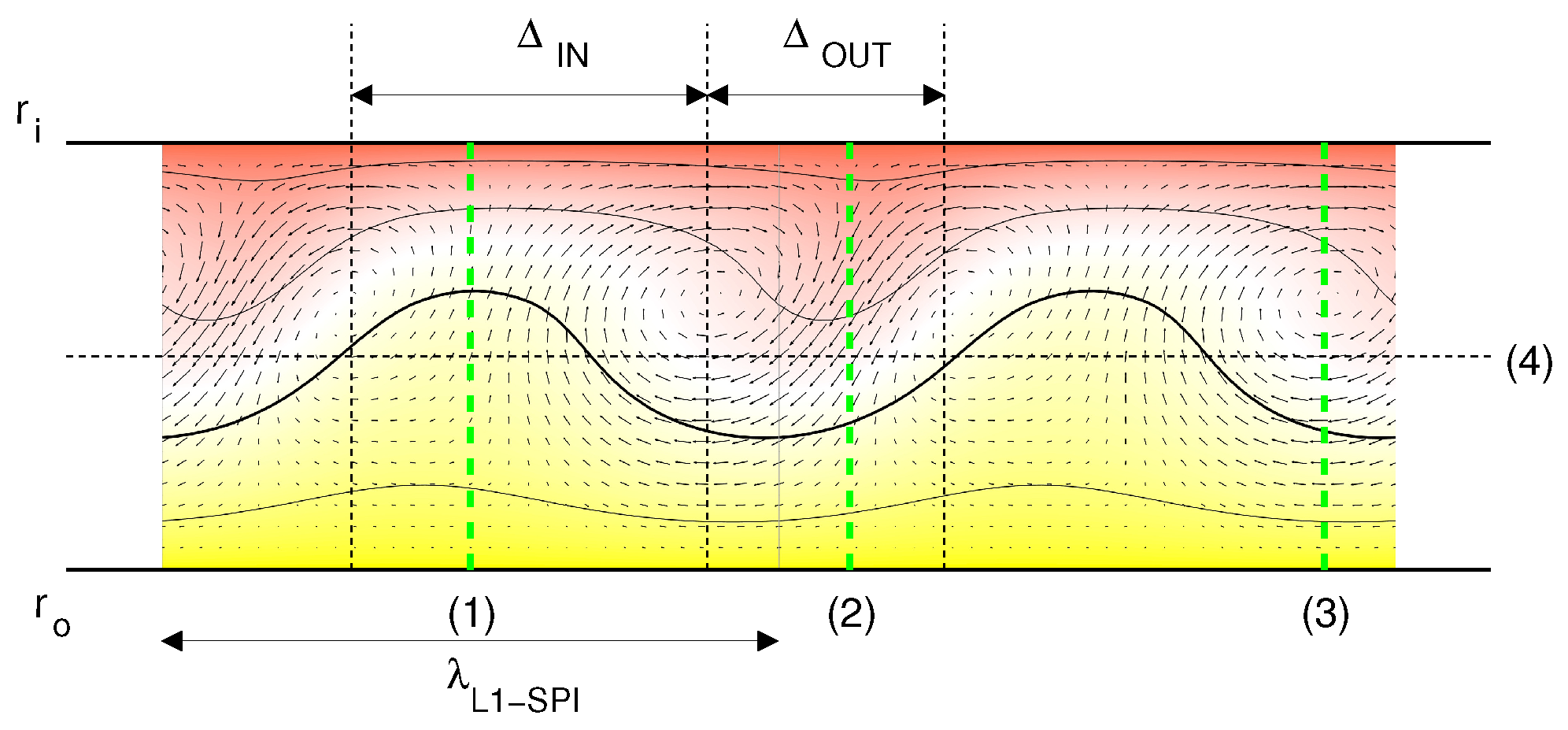
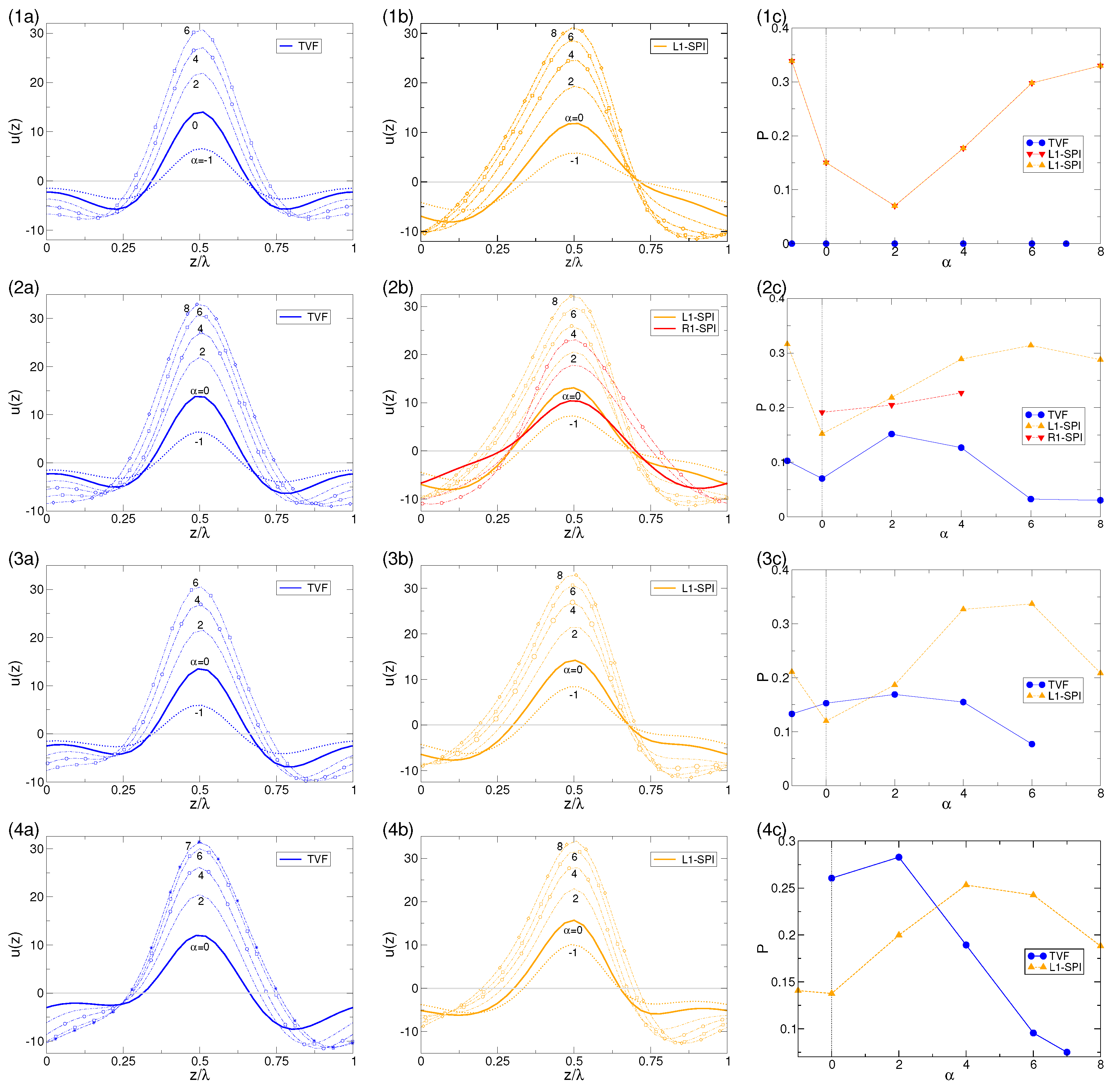

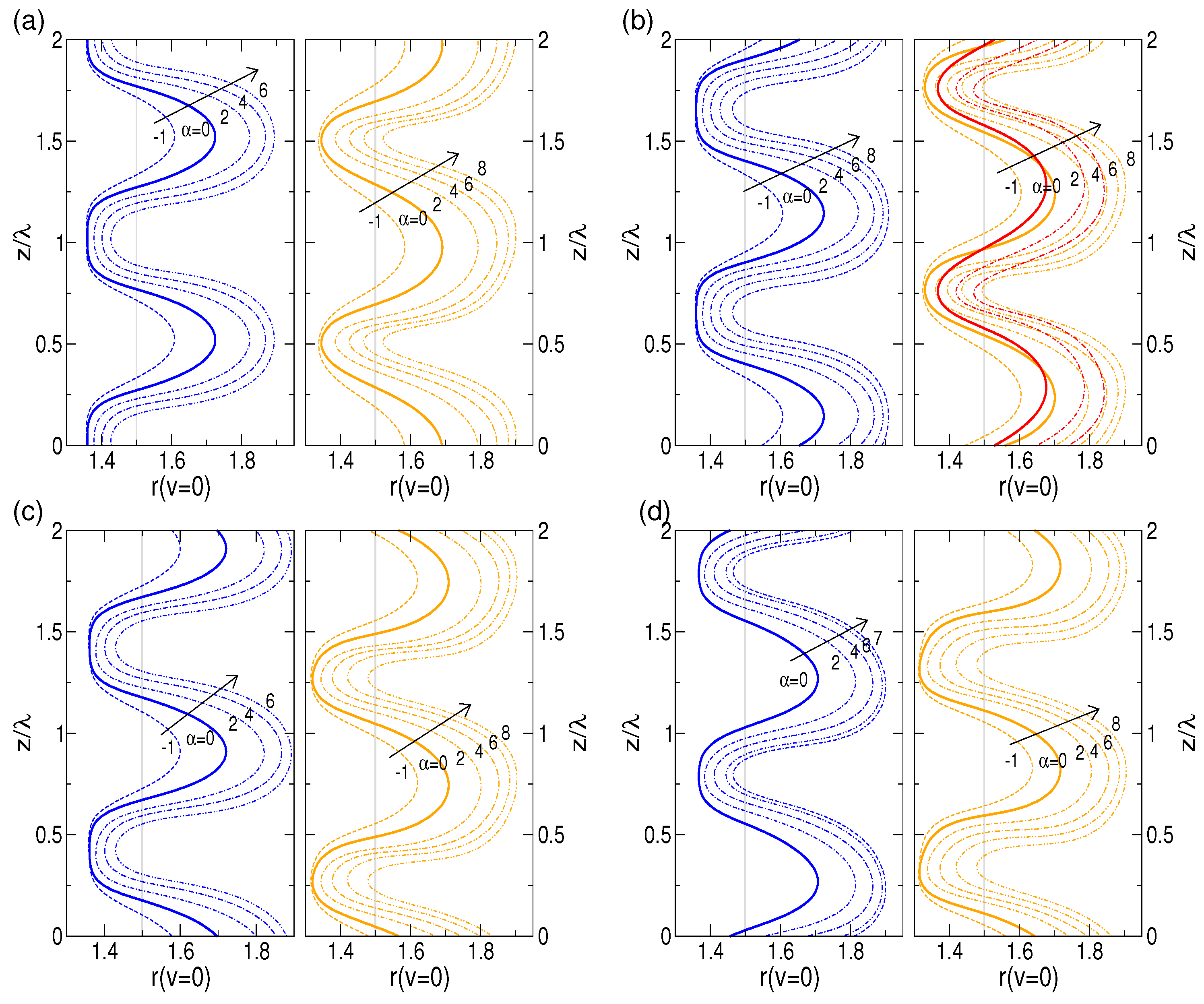

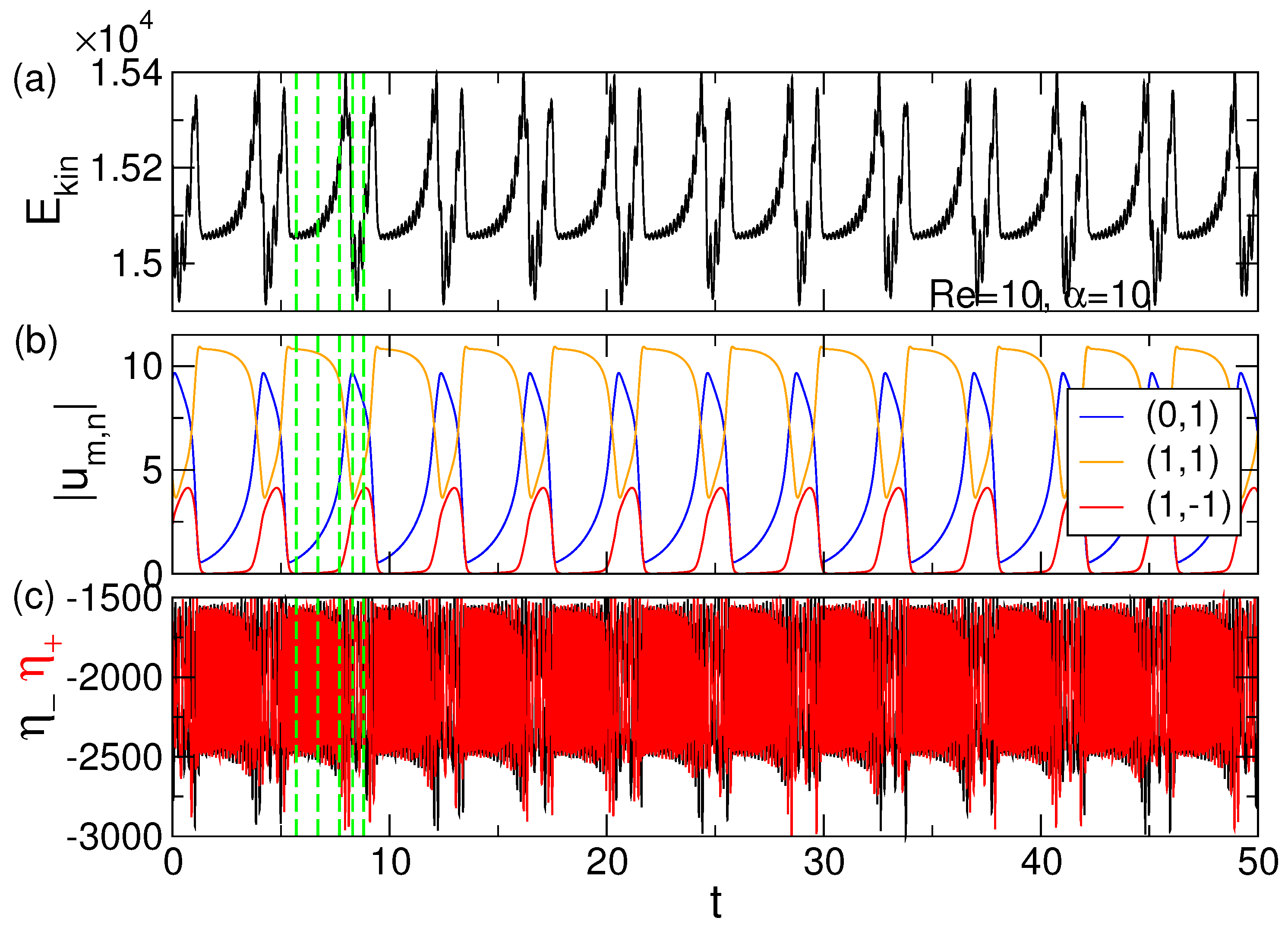
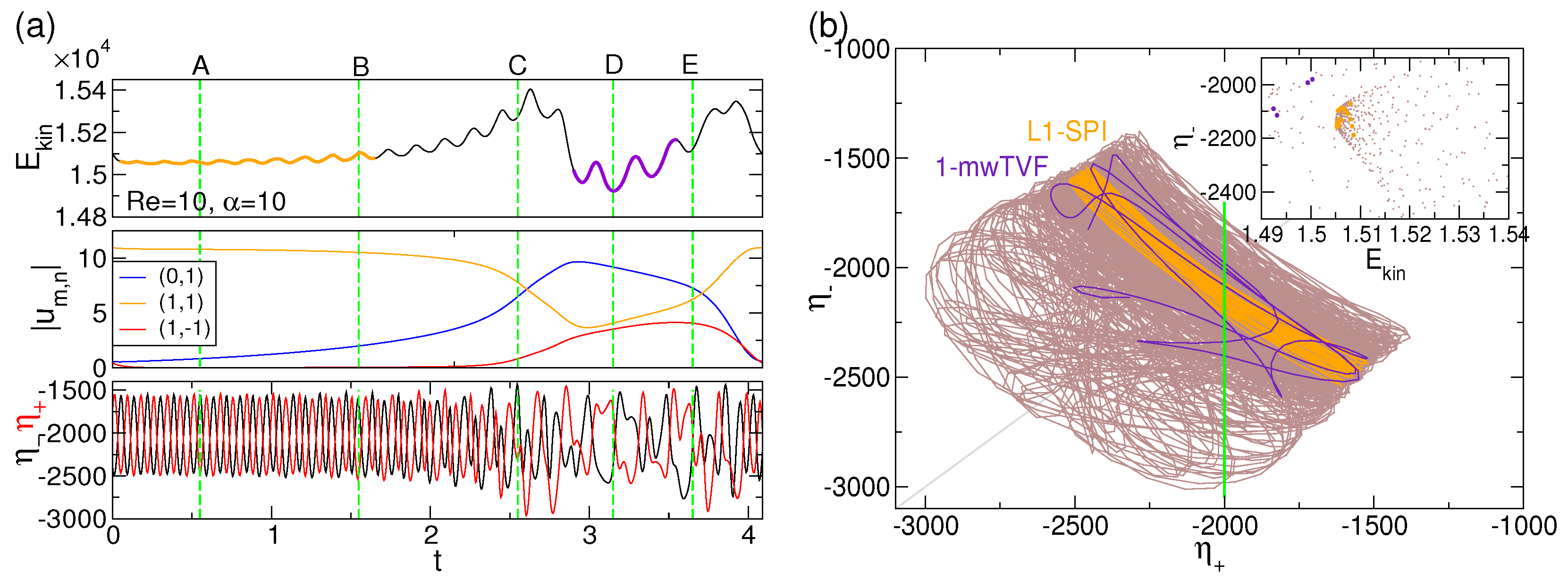
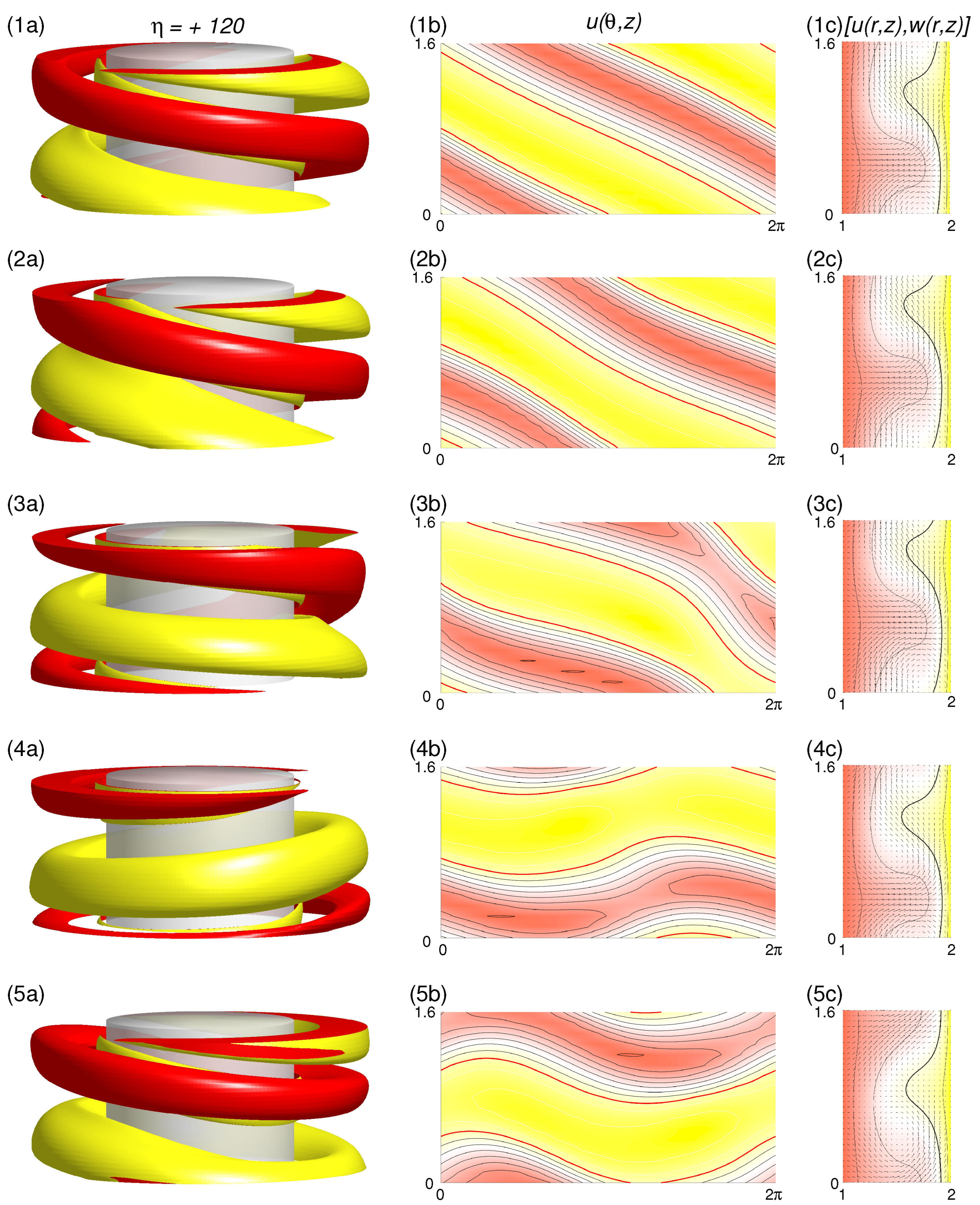
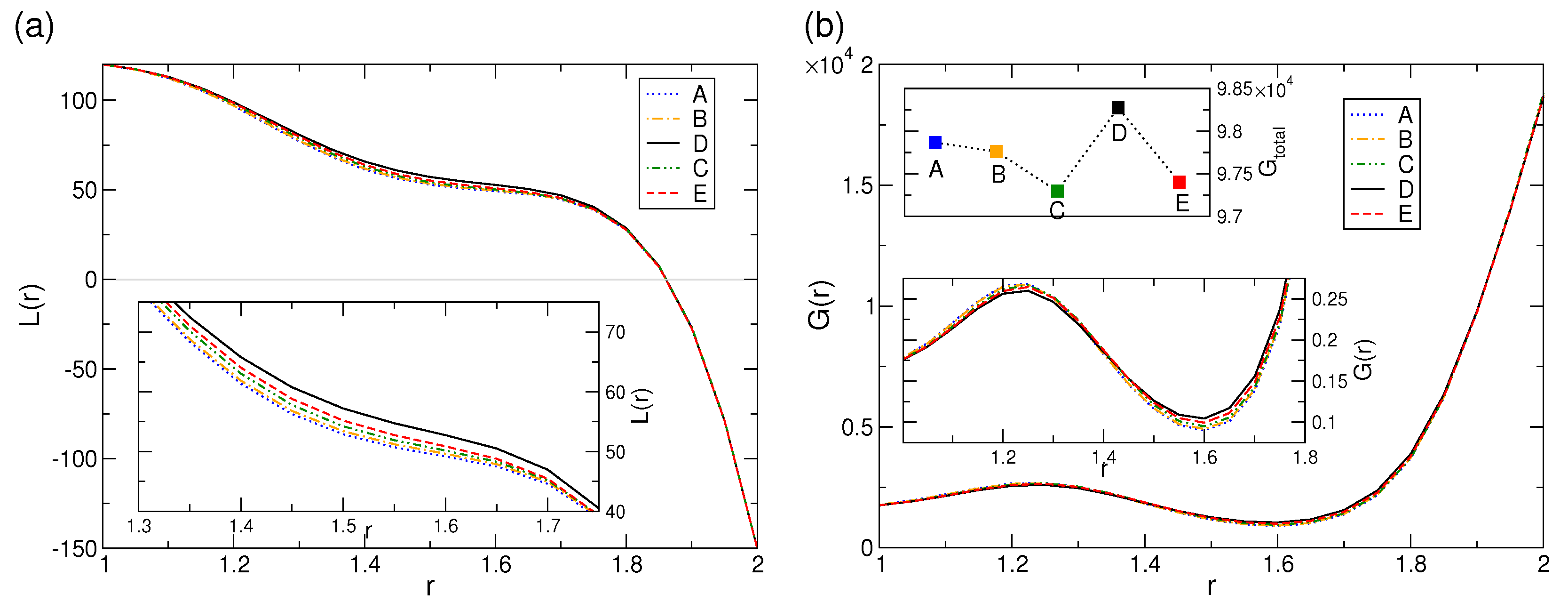

| Abbreviation | Flow State | Modes m (Dominant) | Dynamics |
|---|---|---|---|
| CCF | Circular Couette flow | 0 | − |
| TVF | Taylor vortex flow | 0 | − |
| 1-[m]wTVF | [modulated] | rotating | |
| wavy Taylor vortex flow | |||
| 1-[m]wTVF | time-dependent [modulated] | rotating | |
| wavy Taylor vortex flow | |||
| L[R]1-SPI | left- [right-] winding | left-[right-]winding, rotating | |
| spiral vortex flow | |||
| 1-RIB | ribbon | rotating | |
| 1-RIB | alternating ribbon | alternating , rotating |
| Solution | Region | ||||||||||||
|---|---|---|---|---|---|---|---|---|---|---|---|---|---|
| A | B | C | C | C | C | C | D | E | F | G | H | I | |
| TVF | - | - | - | - | - | - | - | s | s | - | - | - | - |
| 1-wTVF [1-mwTVF] | - | - | s | s | s | s | s | - | - | - | - | - | - |
| 1-wTVF [1-mwTVF] | - | - | - | - | - | - | - | - | - | - | s | - | - |
| L1-SPI | s | s | s | s | s | - | - | s | s | - | - | - | - |
| R1-SPI | - | s | - | - | s | - | - | - | s | - | - | - | - |
| 1-RIB, 1mRIB | - | - | - | - | - | - | - | - | - | - | - | s | - |
| 1-RIB [1-mRIB] | - | - | - | - | - | - | - | - | - | - | - | - | hc |
| 1-mwTVF↔1-mwSPI | - | - | - | - | - | - | - | - | - | hco | - | - | - |
Publisher’s Note: MDPI stays neutral with regard to jurisdictional claims in published maps and institutional affiliations. |
© 2022 by the author. Licensee MDPI, Basel, Switzerland. This article is an open access article distributed under the terms and conditions of the Creative Commons Attribution (CC BY) license (https://creativecommons.org/licenses/by/4.0/).
Share and Cite
Altmeyer, S.A. Effect of Axial and Radial Flow on the Hydrodynamics in a Taylor Reactor. Fluids 2022, 7, 336. https://doi.org/10.3390/fluids7100336
Altmeyer SA. Effect of Axial and Radial Flow on the Hydrodynamics in a Taylor Reactor. Fluids. 2022; 7(10):336. https://doi.org/10.3390/fluids7100336
Chicago/Turabian StyleAltmeyer, Sebastian A. 2022. "Effect of Axial and Radial Flow on the Hydrodynamics in a Taylor Reactor" Fluids 7, no. 10: 336. https://doi.org/10.3390/fluids7100336
APA StyleAltmeyer, S. A. (2022). Effect of Axial and Radial Flow on the Hydrodynamics in a Taylor Reactor. Fluids, 7(10), 336. https://doi.org/10.3390/fluids7100336







